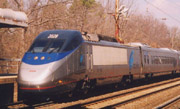 Photo by Steve Dunham
By Steve Dunham. From | ||||||
Return to Transportation Security Topics
| |||||||
Public transportation was under assault by terrorists long before
Because of the history of attacks on public transportation, notably in Britain, where the London Underground was repeatedly a target for the Irish Republican Army, transit system managers have long been aware of transit’s vulnerability. Even so, the
During rush hour, a subway train may be carrying over a thousand people, and an explosion, derailment, or biological or chemical attack in the confined space of a tunnel or underground station holds the potential for high casualties.
Mainline U.S. railroad passenger cars (not transit vehicles such as subways and trolleys) are less vulnerable: their rugged construction tends to prevent fatalities in all but the worst wrecks, but they have been the targets of terrorism just the same.
To defend railways against terrorism, the tools are there, as well as the experience, both in America and abroad. Best practices within the transit industry are being shared and examined for implementation where appropriate. Many systems, particularly the larger ones, have had longstanding efforts to combat terrorism. Although to some extent their efforts are reactive, there is emphasis on preparing for the unexpected.
John J. Haley, a managing principal of Booz Allen Hamilton, said that it is necessary to acknowledge the open nature of transit; the right balance is to recognize the limits of technology while promoting innovation, which may come in the form of policies and procedures rather than technology.
Freight traffic is also at risk. “Terrorists may seek to endanger the population by attacking trains carrying hazardous or nuclear materials,” noted
“Terrorists may seek to disrupt essential governmental shipments of military equipment by attacking trains or routes essential to that traffic,” he continued. “Terrorists may seek to disrupt the
Immediately following the
Narrowing the focus, DHS is assessing nine rail freight corridors in metropolitan areas, according to the TSA’s Emilie Guerin. The assessments include information gathering, inspection trips, onsite review, freight rail hazard analysis, and tabletop exercises. Risk is ranked by hazard, system security, access control, and en route security.
At the Railway Age Railway Security Forum and Expo in Washington, DC, last month, Tim O’Toole, managing director of the London Underground, offered lessons from the July 2005 bombings his system suffered. Although these lessons come from a large urban transit system, they could assist the industry and the entire field of homeland security:
Annabelle Boyd and
Steve Dunham, “Mass Transit Defends Itself Against Terrorism,” Journal of Homeland Security, March 2002.
Steve Dunham, “The ‘Oh’ Police: Transit Police and Counterterrorism,” Journal of Homeland Security, July 2002.
Steve Dunham, “Securing Rail Freight,” Journal of Homeland Security, February 2003.
Steve Hirano, “Staying Focused on Rail Security,” Metro, January 2006.
Brian Michael Jenkins and
Transit Security Handbook,
“Recommended Emergency Preparedness Guidelines for Rail Transit Systems,”
William C. Thompson, “Railroad Infrastructure Security” presentation, Transportation Research Board,